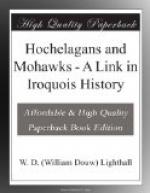by twelve or fifteen,” that it appears to be
the result of inaccurate drawing. There is therefore
considerable room for difference as to the population
of the town, ranging from say 1,200 to 2,000 souls,
the verbal description which is much the more authoritative,
inclining in favour of the latter. Any estimate
of the total population of the Hochelagan race on the
river, must be a guess. If, however, those on
the island of Montreal be set at 2,000, and the “more
than 500” of Stadacona be considered as a fair
average for the principal town and 300 (which also
was the average estimated by Pere Lalemant for the
Neutral nation) as an average for the eight or so
villages of the Quebec district, (the absentees, such
as the 200 at Gaspe from Stadacona being perhaps offset
by contingents from the places close to Stadacona)
we have some 4,900 accounted for. Those on all
the hills to the south and east of Mount Royal would
add anywhere from say 3,000 to an indefinitely greater
number more. Perhaps 5,000, however, should not
be exceeded as the limit for these hills and Lake
Champlain. We arrive therefore at a guess of from
7,900 to 9,900 as the total. As the lower figures
seem conservative, compared with the early average
of Huron and Iroquois villages, the guess may perhaps
be raised a little to say from 10,000 to 11,000.
“This people confines itself to tillage and
fishing, for they do not leave their country and are
not migratory like those of Canada and Saguenay, although
the said Canadians are subject to them, with eight
or nine other peoples who are on the said river.”
Nevertheless the site of Hochelaga, unearthed in 1860,
shows them to have been traders to some extent
with the west, evidently through the Ottawa Algonquins.
What Cartier did during his brief visit to the town
itself is well known. The main point for us is
that three men led him to the top of Mount Royal and
showed him the country. They told him of the
Ottawa River and of three great rapids in the St.
Lawrence, after passing which, “one could sail
more than three moons along the said river,”
doubtless meaning along the Great Lakes. Silver
and brass they identified as coming from that region,
and “there were Agojudas, or wicked people,
armed even to the fingers,” of whom they showed
“the make of their armor, which is of cords and
wood laced and woven together; giving to understand
that the said Agojudas are continually at war with
one and other.” This testimony clearly describes
the armour of the early Hurons and Iroquois[5] as found
by Champlain, and seems to relate to war between the
Hurons and Senecas at that period and to an aversion
to them by the people of the town of Hochelaga themselves;
who were, however, living in security from them at
the time, apparently cut off from regular communication
with them by Algonquin peoples, particularly those
of the Ottawa, who controlled Huron communication
with the lower St. Lawrence in the same way in Champlain’s
days.




